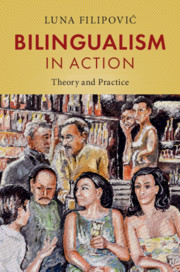Book contents
- Bilingualism in Action
- Bilingualism in Action
- Copyright page
- Dedication
- Contents
- Figures
- Tables
- Preface
- Acknowledgements
- 1 Introduction
- 2 Bilingualism Research
- 3 Introducing CASP for Bilingualism
- 4 Action Time
- 5 Bilingual Cognition
- 6 Bilinguals in Action as Language Professionals
- 7 Conclusions and Future Directions
- References
- Language Index
- Name Index
- Subject Index
2 - Bilingualism Research
What We Know and What We Need to Know
Published online by Cambridge University Press: 10 October 2019
- Bilingualism in Action
- Bilingualism in Action
- Copyright page
- Dedication
- Contents
- Figures
- Tables
- Preface
- Acknowledgements
- 1 Introduction
- 2 Bilingualism Research
- 3 Introducing CASP for Bilingualism
- 4 Action Time
- 5 Bilingual Cognition
- 6 Bilinguals in Action as Language Professionals
- 7 Conclusions and Future Directions
- References
- Language Index
- Name Index
- Subject Index
Summary
The chapter provides a selective and critical account of some central theoretical and empirical insights into bilingualism, relating to how bilinguals learn, process and store their languages. We look at the similarities and differences between monolingual and bilingual language acquisition and use. I offer a succinct overview of factors that have been studied at length in the field, such as age of acquisition and proficiency, and consider also those that have received rather less attention even though they are equally important for understanding and predicting bilingual language outputs, such as the language profiles of interlocutors and communicative situation type. The chapter ends with a summary discussion of key points in bilingual processing, highlighting the central unanswered questions and challenges in bilingualism research that we take up in the following chapters.
- Type
- Chapter
- Information
- Bilingualism in ActionTheory and Practice, pp. 11 - 50Publisher: Cambridge University PressPrint publication year: 2019

